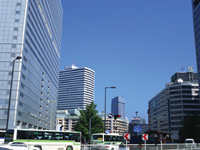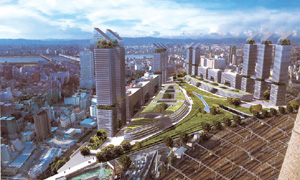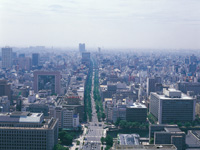Osaka Revitalization amid Plummeting Prices
Back to Contents of Issue: December 2003
|
|
|
|
by Alex Stewart |
|
|
Osaka's property prices have declined steadily since the end of the bubble economy. In 1992, the average asking price for office properties in the city zone was over JPY16,000 per tsubo (3.3 square meters). In September 2003, it was down to JPY9,650, according to data supplied by Ikoma Data Services.
The slide in land prices has been even more severe. According to Ichiro Kumazawa, chairman of the Osaka Real Estate Appraisal Association, if pre-bubble land prices in 1983 are indexed at 100, the corresponding index in 2002 was 56.3 for commercial property. In fact, he says, prices are equivalent now to 1972 levels if adjusted for increased economic buying power. In short, most of the last 30 years or more of property speculation has gone up in smoke.
Since the bubble, Osaka's economy has suffered a severe lack of investment, especially from overseas (the FDI to GDP ratio is so small it barely registers). Following the financial "Big Bang" and other steps to deregulate the economy, more foreign capital, more know-how and ultimately more head office functions have moved to Tokyo.
The Tokyo exodus largely accounts for the soft state of the Osaka office market in the last five years. So long as there is a continuing outflow of major tenants, the risk for property developers remains high. Very little foreign capital has entered the market, although companies like GE Capital are beginning to become more active.
Osaka has long wanted to maintain its standing as Japan's "second city," and has even tried to maintain a set of institutions that parallel Tokyo's. Osaka is the home of several of the largest general contractors and house-building companies in Japan. Building -- almost for its own sake -- is one of the city's passions.
The result is a city with hardly any open space, which is now a major handicap for planning a post-industrial city. What Osaka has instead is the longest and largest underground and over-ground shopping malls in Japan, a gleaming international airport that is a major financial liability, and until the recent building spree in Tokyo, one of Japan's tallest skyscrapers.
Osaka is still a genuine metropolis. In its downtown area, which is not much larger than two of Tokyo's central wards, Osaka contains all the vitality and variety of the capital city, minus the conspicuous wealth and international business activity. There is an opportunity for Osaka to promote itself to a wider audience, especially since it stands at the gateway to a regional economy larger than that of Taiwan.
What Osaka needs to do is reinvent itself, not as a second city, but as a new style of regional city, like Glasgow and Manchester in the UK. Its best chance to do this has been activated by the central government's policy to use urban regeneration, increased tourism and foreign direct investment as levers to stimulate domestic demand and fight deflation.
Prime Minister Koizumi established the Urban Renaissance Headquarters in May 2001 under the Cabinet Office. In July 2002, the office designated 17 sites in four main metropolitan areas for promotion under special measures drawn up to simplify planning consent and building regulations. (The number of designated areas has since expanded to 52 nationwide.) The Osaka region obtained the highest number: four for the city and four for the prefecture, the latter mostly on the outskirts of the city itself. The government also introduced the Special Measures for Urban Renewal Law, which provides financing for the selected "urban renewal districts."
The new Urban Renewal Law simplifies building permit processes and reduces the time-risk which hampers many large-scale projects. The law also allows local governments to obtain central government funding for half the cost of building infrastructure -- activities such as widening roads, creating open spaces or implementing new traffic systems within the designated urban renewal areas.
From a commercial point of view, the parts of the city with the most potential for development are where people already congregate, which in Japan generally means the main railway hubs. Strengthening them helps improve land values. (In the past, Osaka has created new projects in new areas, hoping to draw investment to them.)
There are three hubs in the Osaka city regeneration plans. The most important is the Umeda hub, which is the terminus for three railways -- JR, Hankyu and Hanshin -- and three subway lines. Three department stores are located in the hub: Hankyu, Hanshin and Daimaru. Two years ago Yodobashi Camera opened a large store on the north side of the station, while Mitsukoshi is planning to build a new store over the JR Umeda railway station itself. Umeda has the highest land prices (JPY12,930 per tsubo) and one of the lowest vacancy rates alongside the Dojima/Nakanoshima area, which is the traditional home of the pharmaceutical industry and several other major companies, according to Ikoma Data Services.
The key to the development of Umeda is the former Japan National Railways freight yard north of the station. The scale and location of the site are unique not only in Osaka but in the rest of Japan. The site is comparable to Shiodome in Tokyo, which was also a former Japan National Railways yard. Shiodome is a 31-hectare site, while North Umeda is 24 hectares. Shiodome's development has been underway for several years, with completion planned by 2006.
North Umeda is now the largest piece of city center real estate for development in Japan. It may take longer to develop than Shiodome, partly because funding is more difficult to obtain in Osaka, and also because it is a more complicated site to integrate quickly into its surroundings. However, in terms of its strategic location for helping to create a more visitor-oriented city, North Umeda is unparalleled. Indeed, so much is riding on it becoming the new focal point of the Kansai region that there is talk (but no concrete plan) to divert the Shinkansen line from Shin-Osaka station, which is something of a black hole in terms of property prices, to Osaka's North Umeda.
The first six hectares -- nearest to the station and therefore prime land -- are due to go on sale by the second half of 2004. Speculation is rife that a major Tokyo developer will win the bidding. It is not difficult to see why, since Osaka cannot match the financing power of Tokyo. Among the benefits of having a Tokyo developer would be to import the experience of building one of Tokyo's "castle towns," such as Shiodome and Roppongi Hills.
In spite of all this, there are still many risks for a developer, given the weakness of the local property market. The city has a blueprint in mind for the area, based on an international competition for a mixed office, residential and cultural nexus that is supposed to ensure a cosmopolitan meeting place in the heart of the city. In the old days the city would have bought the land itself and ensured that its blueprint was followed by others. But today, the city has no money for investment, so it can only try to influence the developer through using its numerous powers of persuasion. In the current property climate, private developers prefer condo development downtown to office blocks.
After this is done there is a chance that Midosuji can become the focus of a new-style Osaka -- a cosmopolitan tourist-town in the very heart of Kansai.
How will this rosy scenario affect property prices? Kumazawa of the Real Estate Valuation Association in Osaka is willing to believe a visitor-led renaissance scenario would boost property prices in certain downtown locations, especially around Umeda and along the Midosuji Avenue. However, for him as for many others, it is very hard to see prices in most other areas doing more than leveling off. In an era of greater choice, it is clear that some areas will attract strong investment interest from developers, while others may succumb to the broader downward pressures exerted by demographics and structural changes in the economy, such as manufacturing moving offshore and head office functions moving to Tokyo.
A new Osaka, however, which is confident in its status as a regional city, with the potential to become a major destination for Asian visitors as well, will be able to correct the process of migration away to Tokyo. If its urban regeneration plans are achieved, the result will be a stronger tax base, higher property prices and better times ahead for the property industry. Cities in the UK, Europe and the US have shown what urban regeneration can achieve in a post-industrial society. Osaka should be poised to follow suit. @ |
|
Note: The function "email this page" is currently not supported for this page.


 What MAKES OSAKA SPECIAL? A resident Japanese might reply: good okonomiyaki (a pizza-like dish), the origin of cup noodles, the headquarters of Matsushita, the unbreakable spirit of the Hanshin Tigers baseball team and ... falling property prices.
What MAKES OSAKA SPECIAL? A resident Japanese might reply: good okonomiyaki (a pizza-like dish), the origin of cup noodles, the headquarters of Matsushita, the unbreakable spirit of the Hanshin Tigers baseball team and ... falling property prices.
 The city established an Urban Revitalization Task Force in April 2003 to coordinate the various initiatives to revitalize the economy. By using urban regeneration as a platform, Osaka has the opportunity for the first time since the postwar building boom to create a new kind of city -- an urban center that first attracts increased numbers of visitors from Kansai, then from greater Japan, and finally from the whole of Asia. To achieve this, the city needs to market itself differently, upgrade the current infrastructure and reduce real estate investment risk.
The city established an Urban Revitalization Task Force in April 2003 to coordinate the various initiatives to revitalize the economy. By using urban regeneration as a platform, Osaka has the opportunity for the first time since the postwar building boom to create a new kind of city -- an urban center that first attracts increased numbers of visitors from Kansai, then from greater Japan, and finally from the whole of Asia. To achieve this, the city needs to market itself differently, upgrade the current infrastructure and reduce real estate investment risk.
 The best scenario for Osaka would be for the development of the North Umeda site to give fresh inspiration to the many other regeneration projects planned or underway. Of these, probably the most important in carrying on the theme of a gateway and meeting place for cosmopolitan interaction is the redevelopment of Midosuji Avenue. In terms of dimensional space, Midosuji is a true Champs Elysees, longer than the Parisian original and wider than Tokyo's Omotesando. Until recently it was a dull street housing indistinguishable head office buildings. Gradually the original tenants are moving out (due in part to consolidation in the financial sector) and building owners are finding new tenants. The city plans to make the street more like the attractive boulevard it is crying out to be by widening the pavement in places and changing the traffic flow.
The best scenario for Osaka would be for the development of the North Umeda site to give fresh inspiration to the many other regeneration projects planned or underway. Of these, probably the most important in carrying on the theme of a gateway and meeting place for cosmopolitan interaction is the redevelopment of Midosuji Avenue. In terms of dimensional space, Midosuji is a true Champs Elysees, longer than the Parisian original and wider than Tokyo's Omotesando. Until recently it was a dull street housing indistinguishable head office buildings. Gradually the original tenants are moving out (due in part to consolidation in the financial sector) and building owners are finding new tenants. The city plans to make the street more like the attractive boulevard it is crying out to be by widening the pavement in places and changing the traffic flow.




